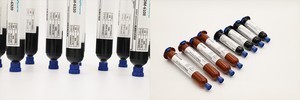SMT Epoxy Adhesive
Featured Product from Shenzhen DeepMaterial Technologies Co., Ltd

Epoxy adhesives are known for their high strength and durability, making them suitable for a wide range of applications, including electronics. SMT epoxy adhesives are formulated to meet the specific requirements of SMT processes. They typically have the following characteristics:
-
Low viscosity: SMT epoxy adhesives have a low viscosity to facilitate easy dispensing and accurate placement during the assembly process. This allows for precise control of adhesive amounts, ensuring proper bonding between components and the PCB.
-
Fast curing: These adhesives are designed to cure rapidly at elevated temperatures, which helps in achieving efficient production cycles. The fast curing time allows for quick handling and further processing of the assembled PCB.
-
High strength: SMT epoxy adhesives provide strong bonds between components and the PCB surface, ensuring mechanical stability even under harsh operating conditions. The high bond strength helps to maintain the integrity of the solder joints and prevent component detachment or failure.
-
Thermal resistance: Electronics often experience temperature variations during operation, and SMT epoxy adhesives are formulated to withstand these temperature extremes. They have good thermal stability and can maintain their performance and bond strength over a wide temperature range.
-
Electrical insulation: SMT epoxy adhesives possess excellent electrical insulation properties, preventing short circuits and ensuring proper electrical isolation between components and the PCB. This characteristic is essential for maintaining the functionality and reliability of electronic devices.
SMT epoxy adhesives are commonly used in the assembly of various electronic components, such as integrated circuits (ICs), resistors, capacitors, and surface mount devices (SMDs). They play a crucial role in providing strong, reliable bonds between these components and the PCB, contributing to the overall performance and longevity of electronic devices.











